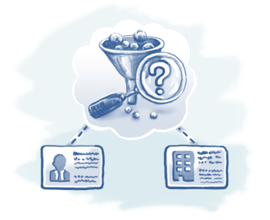In recent articles we have been covering ROI (return on investment) as regards a CRM tool.
Computing ROI for CRM is a much more in-depth undertaking than for many other software solutions. When the full impact for CRM isn’t researched for every portion of the company that will interact with CRM, the company pays handsomely up the road in enormous amounts of wasted time, money and effort.
Often inadequately researched is the impact a CRM application will have on the sales force, along with the potential (considerable) ROI that can be obtained from making the right choice for Sales.
 Traditional Approach
Traditional Approach
In the past, when a company was researching out and then purchasing and implementing a CRM tool, the sales force was rarely consulted. The whole idea was to have a method by which salespeople could be monitored; rarely if ever was the proposition made that CRM tool should actually assist sales reps in making sales.
This approach has been so ingrained in company thinking that the costs actually being incurred have become more or less hidden. Nobody considers that because salespeople are having to come up with alternative solutions to their pipeline management (such as spreadsheets) that it results in extra costs. But not only is a sales rep having to do double duty entering sales data both in CRM and in their own solution, the company pays dearly in another way, too: the information entered in the salesperson’s own solution is lost to the rest of the sales force and the company.
Another substantial time cost is the meetings between sales management and sales reps to collect information, prepare reports and create forecasts; all of this functionality should be part and parcel of CRM.
Casting Tradition Aside
The modern approach to computing potential CRM ROI is to start from scratch without having any particular CRM solution in mind. Every possible department and person that interacts with CRM is consulted in depth for what they would actually require from it.
Factually this inquiry should begin with the sales force, for it will be they who benefit the most from CRM. Actually sit down with each sales rep and find out what it would take for a CRM solution to assist them in making sales. What functionality would it take for them to do away with their own “solutions”?
It will most likely be found that CRM needs to be intuitive and easy for sales reps to enter data. Then, data must be easily retrievable when they need it. The best way for this to occur is to utilize a CRM tool that mirrors the company’s sales process. The sales force knows and follows the sales process; it will therefore be a snap for them to follow CRM.
Then there is sales management, who has been having to spend all that time interacting with reps to create sales analyses and forecasts, time better spent on coaching and managing sales reps. What would sales management require in CRM? Most likely an application through which they could obtain the needed data without the endless meetings that waste both sales rep and manager time.
CRM Tool ROI for Sales Impacts the Whole Company
What kind of ROI is possible if a CRM solution empowers salespeople and sales management instead of costing them considerable time and effort?
First, the CRM application would rapidly pay for itself in the time and effort saved. But well beyond that, because salespeople and sales management can actually focus on their jobs (meaning making sales), more sales get made. Not only is the volume of sales increased, but because salespeople and sales management have a greatly increased view and control of their pipelines, sales velocity is also improved; sales can close faster.
Of course all of this means increased revenue. And that’s the kind of ROI that impacts the entire company.
So for getting the most ROI out of a CRM solution—start with the sales force. To put it mildly, the rewards will be well worth it.
Get your free trial of Pipeliner CRM now.




















